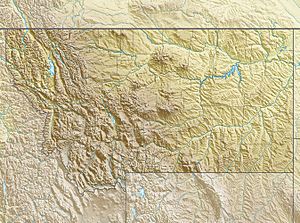Tenmile Creek (Lewis and Clark County, Montana) facts for kids
Quick facts for kids Tenmile Creek |
|
|---|---|
|
Location of the headwaters of Tenmile Creek in Lewis and Clark County, Montana
|
|
| Country | United States |
| State | Montana |
| County | Lewis and Clark County |
| Physical characteristics | |
| Main source | East side of the Continental Divide in southern Lewis and Clark County, Montana 7,120 ft (2,170 m) 46°25′36.7392″N 112°18′50.3706″W / 46.426872000°N 112.313991833°W |
| River mouth | Prickly Pear Creek Lewis and Clark County, Montana 3,663 ft (1,116 m) 46°40′24.5382″N 111°58′32.973″W / 46.673482833°N 111.97582583°W |
| Length | 26.5 mi (42.6 km) |
| Basin features | |
| Basin size | 200 sq mi (520 km2) |
Tenmile Creek is a stream about 26.5-mile (42.6 km) long in Lewis and Clark County, Montana. It flows into Prickly Pear Creek. This creek is important because it provides about half of the drinking water for Helena, the capital city of Montana.
Contents
Where is Tenmile Creek Located?
Tenmile Creek starts high up in the Rocky Mountains. It begins on the east side of the Continental Divide. The Continental Divide is like a big ridge where water on one side flows to the Atlantic Ocean and water on the other side flows to the Pacific Ocean.
The upper part of the creek flows through steep, forested mountains. The lower part of the creek travels through flat areas and busy neighborhoods near Helena. It then joins Prickly Pear Creek. Lake Helena is not far from where these two creeks meet.
How Does the Water Flow?
Tenmile Creek is a typical mountain stream. It has the most water in late spring and early summer. This is when snow melts from the mountains and there is a lot of rain.
What is the Land Around the Creek Used For?
In the upper parts of the creek's watershed (the area where all the water drains into the creek), people enjoy outdoor activities like hiking. There is also some timber harvesting, which means cutting down trees for wood. A small town called Rimini, Montana is in this area.
The lower part of the watershed is mostly used for farms, ranches, and city areas. Farmers use a lot of water from Tenmile Creek to water their crops. Sometimes, this can make parts of the creek dry. However, some of this water returns to the creek later.
Cleaning Up Tenmile Creek
For many years, from the 1870s to the 1990s, people mined for minerals in the mountains near Tenmile Creek. When water flows over or through old mines and leftover mining waste, it can pick up harmful substances. These substances, like arsenic, copper, and lead, can then get into Tenmile Creek.
The upper 13 miles (21 km) of the creek is part of a special cleanup area called a Superfund site. This means it is a place with pollution that needs to be cleaned up by the government. Sometimes, the water in the creek has levels of these substances that are too high for people to drink safely. So, the water needs to be treated before it can be used.
As of 2012, there were about 150 old or unused mines in the area. Cleanup efforts began in 1996 to make the area safer. Between 2002 and 2010, the United States Environmental Protection Agency and the state of Montana spent a lot of money. They worked to design and build special plants to treat the water and remove contaminated soil.
Helena's Drinking Water Supply
Tenmile Creek provides about half of the drinking water for the city of Helena. People started using water from the creek for the city in the 1880s. A company built a system of wooden flumes (channels) and trestles (bridges) to carry the water to homes.
The city of Helena bought this system in 1911 and still uses it today. The city has rights to use a certain amount of water from the creek, which is about 8.9 million gallons per day.
How Helena Stores Water
The city also built two reservoirs, Chessman Reservoir and Scott Reservoir, near where the creek starts. These reservoirs hold extra water when there is a lot of rain or snowmelt. Then, they release this water when the city needs it most, especially in late summer and fall when the creek's water level is low.
Almost all the water from Tenmile Creek that Helena uses is sent through an underground pipeline. It goes to the Tenmile Water Treatment Plant, where it is cleaned and made safe to drink.
Protecting the Water Supply from Fire
Wildfires are a serious danger to Helena's water supply. A fire could destroy the old wooden flume system that carries the water. Also, if a fire burns away trees and plants, it can cause a lot of dirt and ash to wash into the creek. This would make the water unusable for a long time.
To help prevent fire damage, the city of Helena has spent money to create a clear area around parts of the flume. This area is about 432-foot (132 m) wide and has no plants. This helps stop fires from reaching the flume. Since much of the flume is in the Helena National Forest, the city needs permission from the National Forest Service to do more work.
A group called the Tenmile Watershed Collaborative Committee was formed in 2008. They work to find ways to protect the watershed, including preventing fires.
Fish in Tenmile Creek
It is hard for fish to live in Tenmile Creek. This is because the water sometimes has high levels of harmful substances from the old mines. Also, the creek can have very little water, or even dry up, at certain times of the year. Because of these reasons, there are currently no large populations of fish in the creek.


